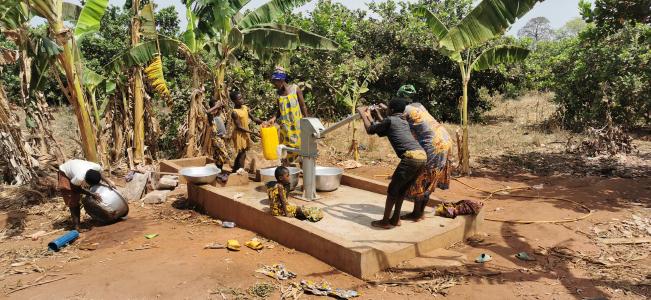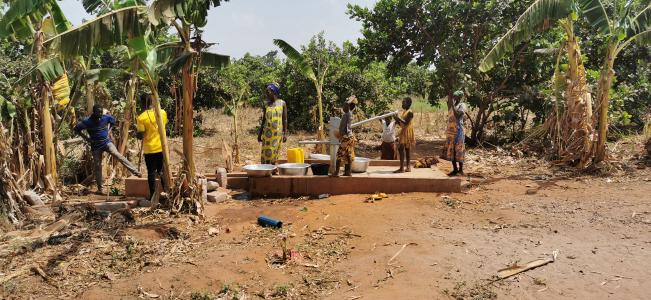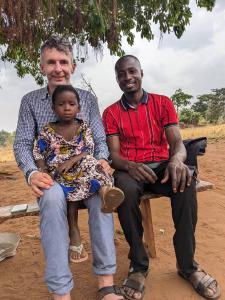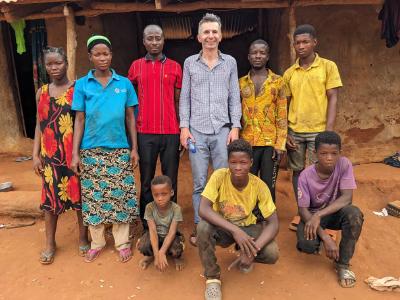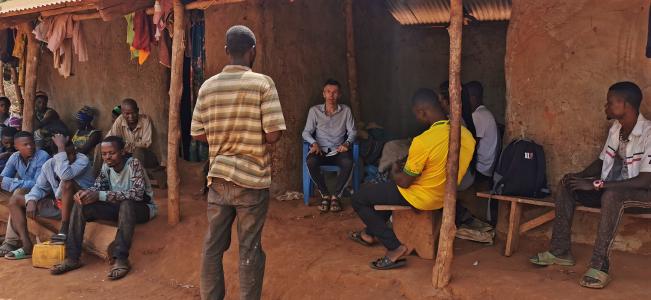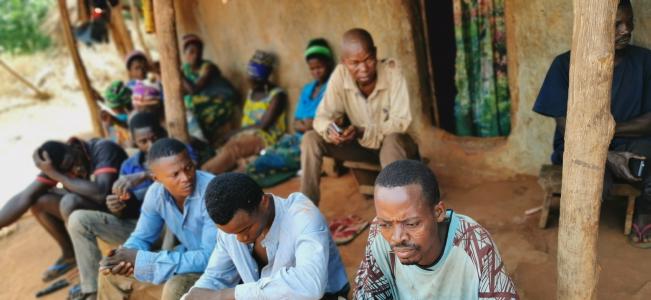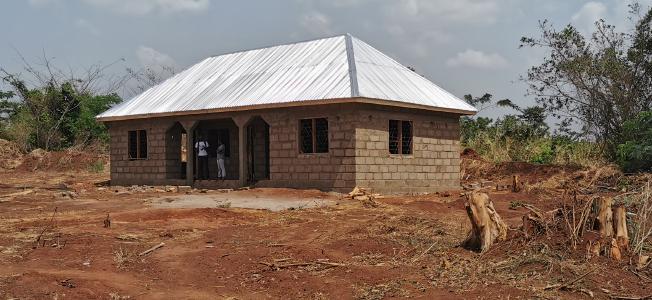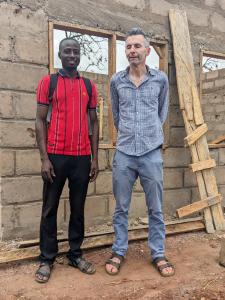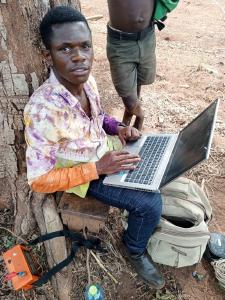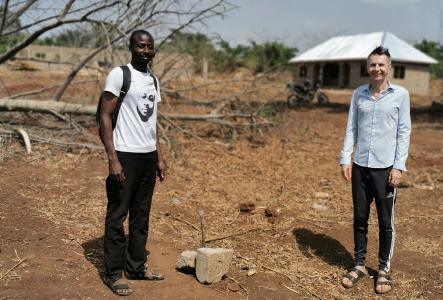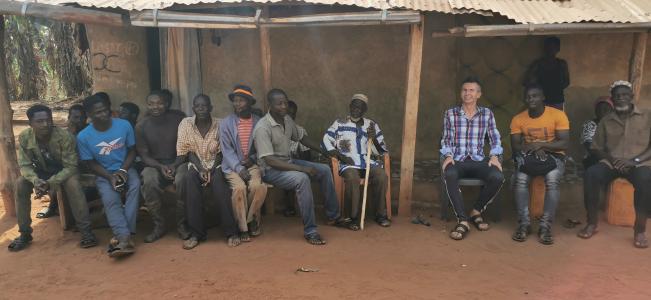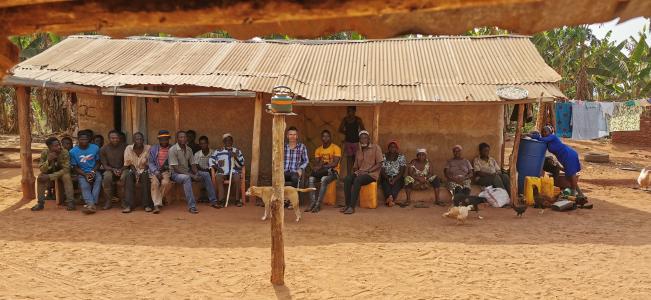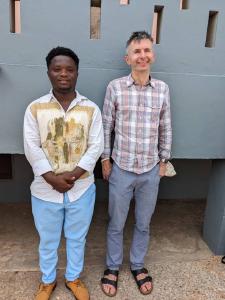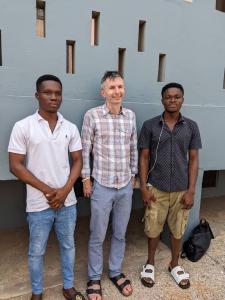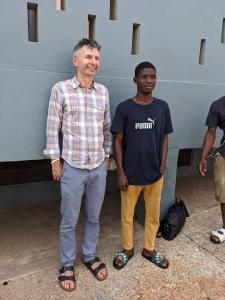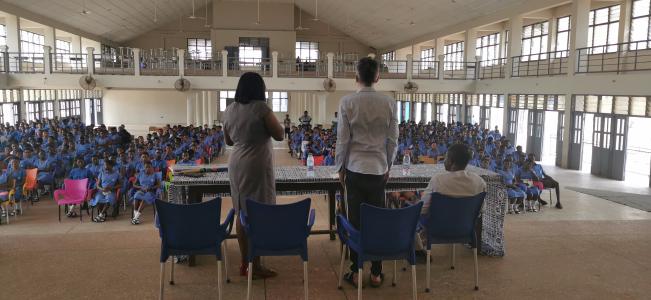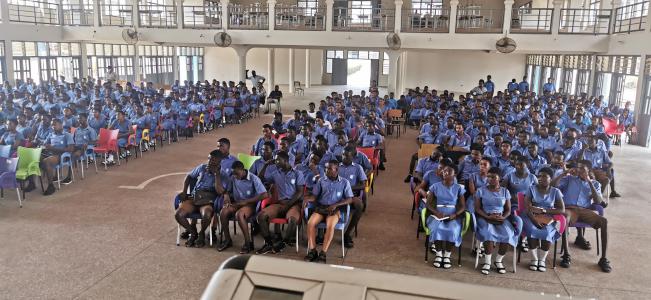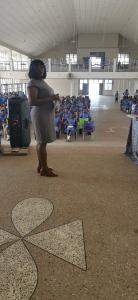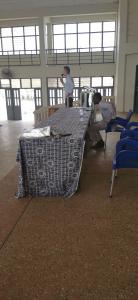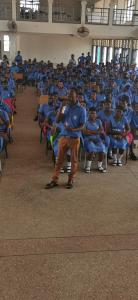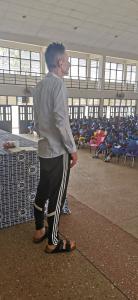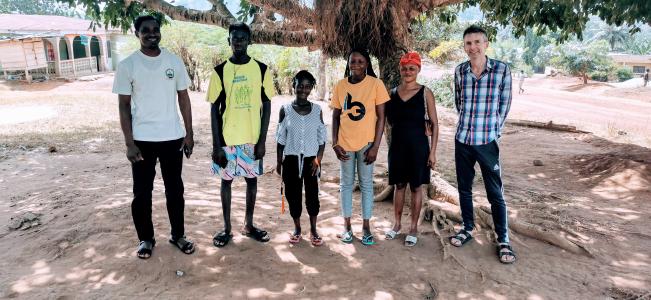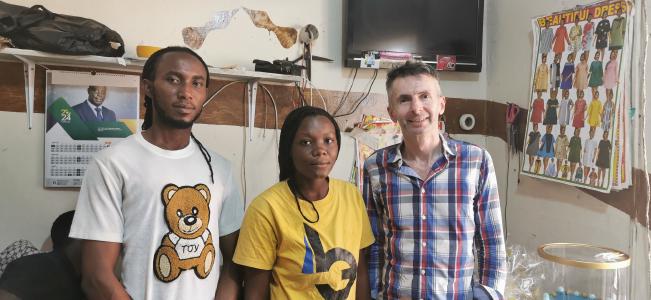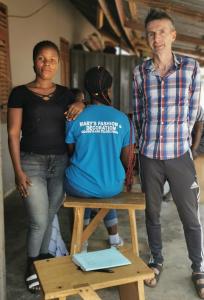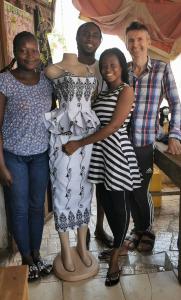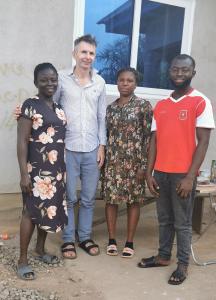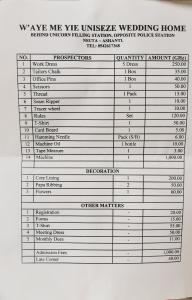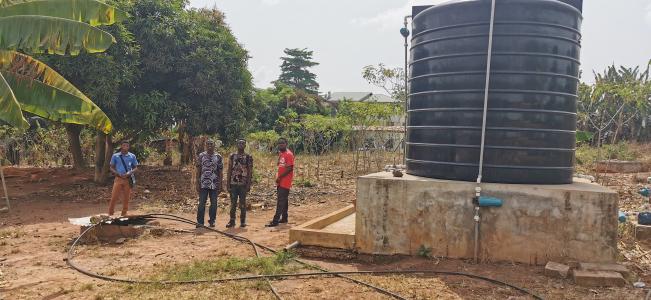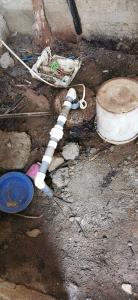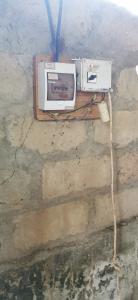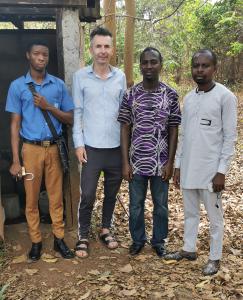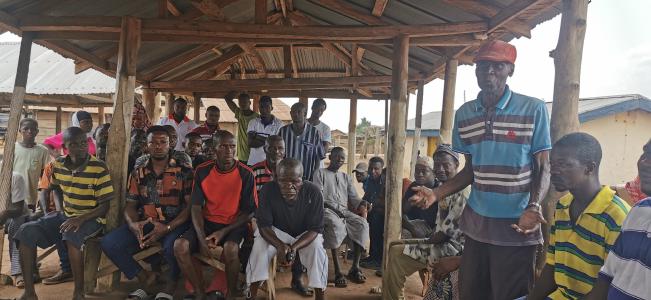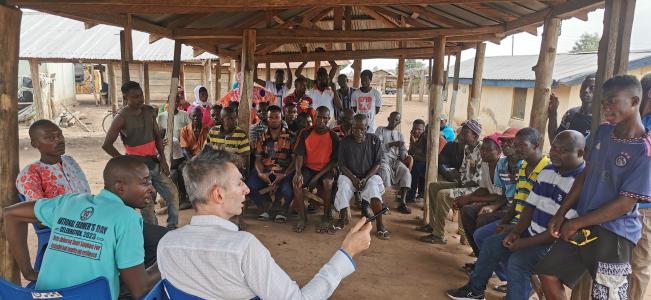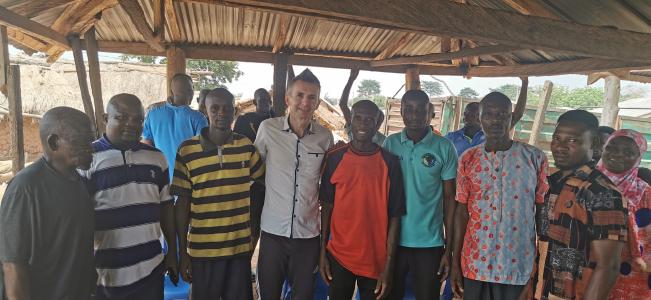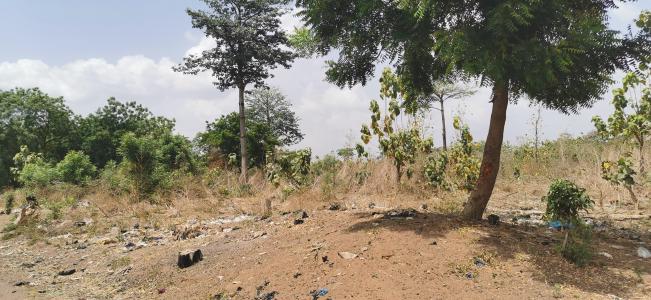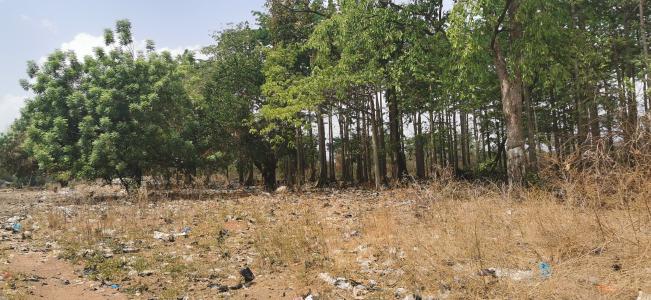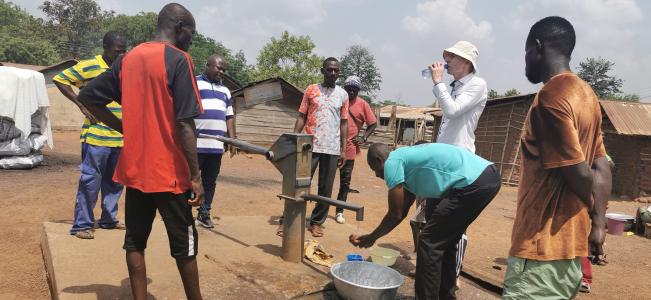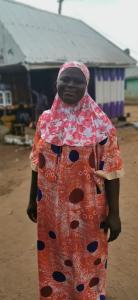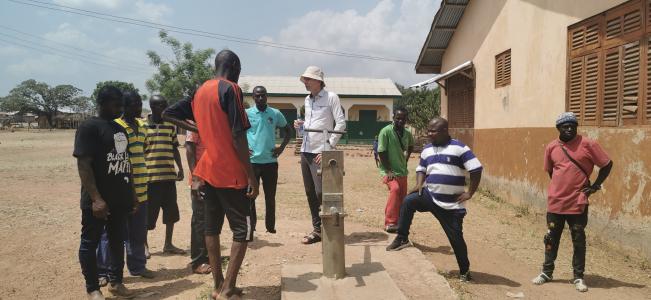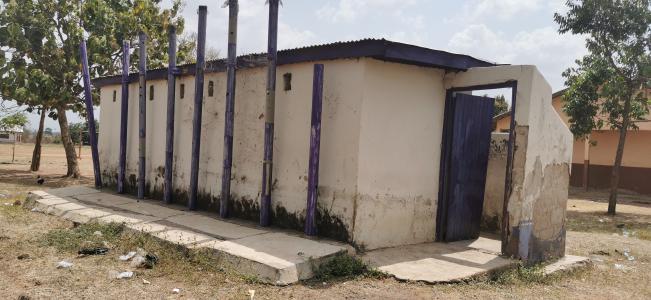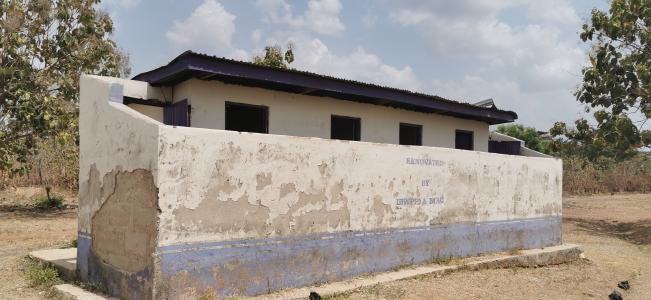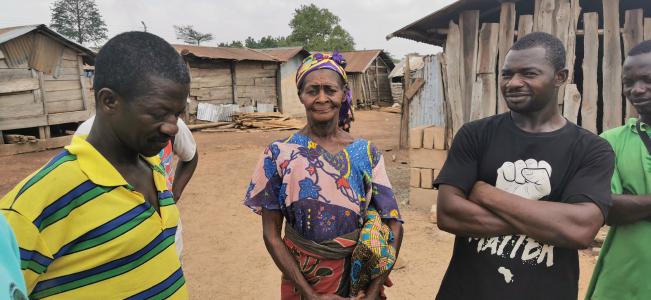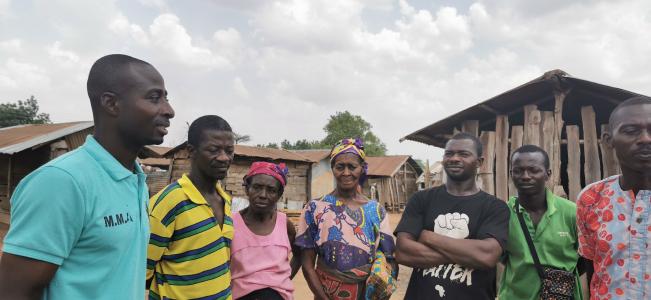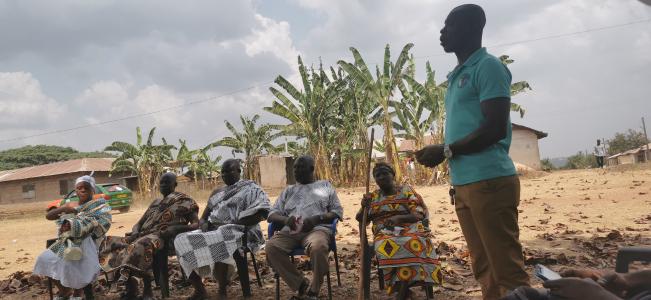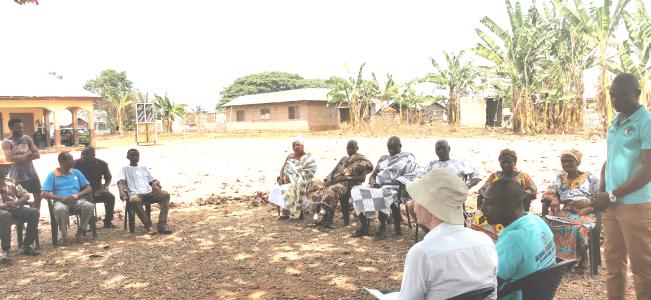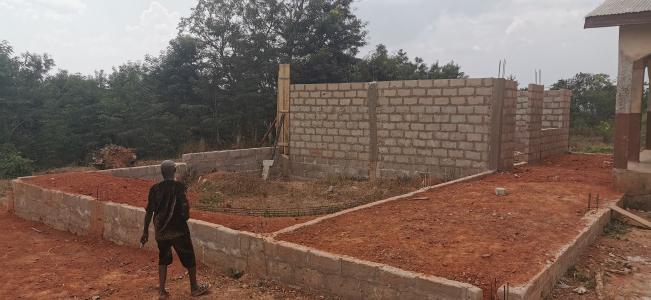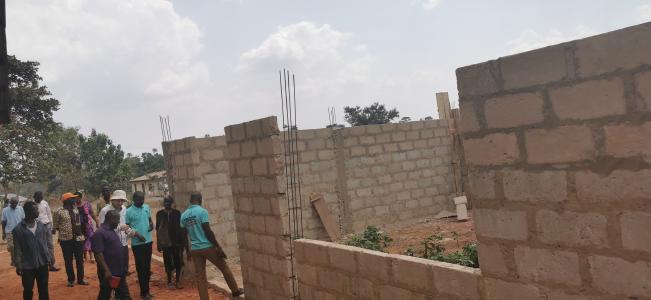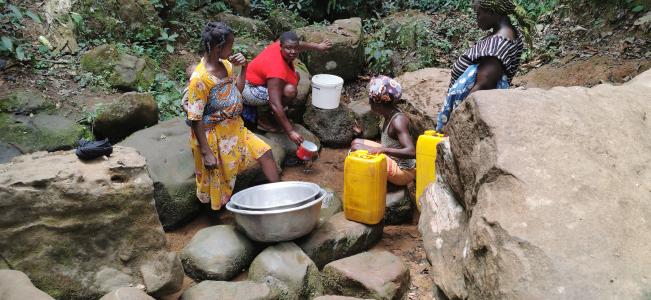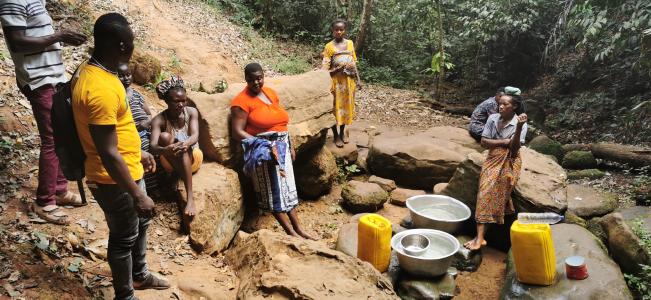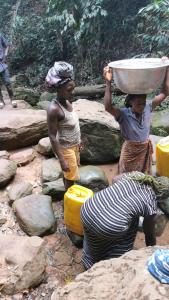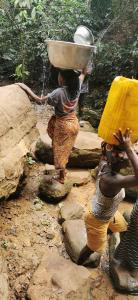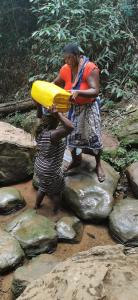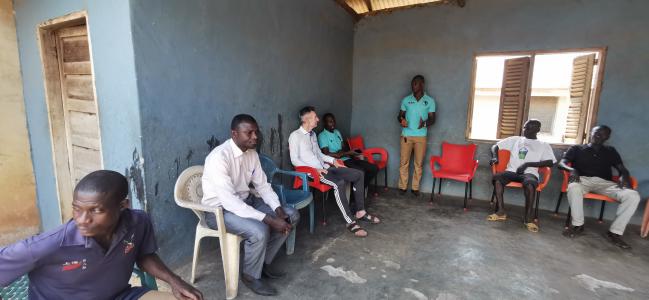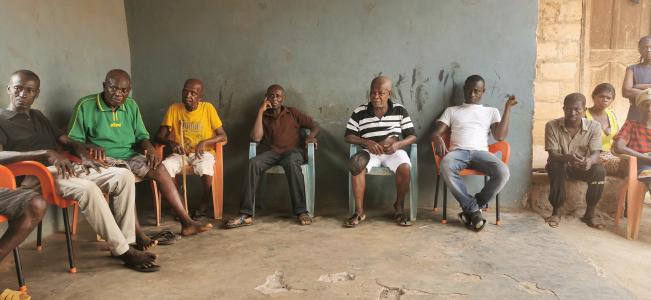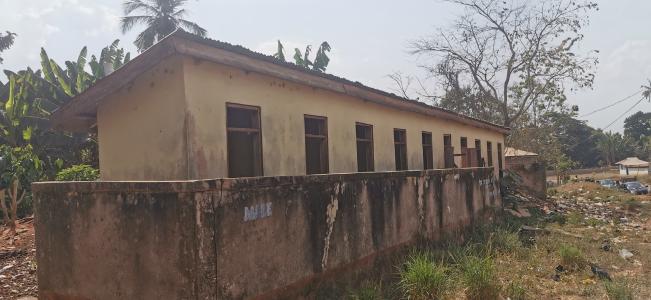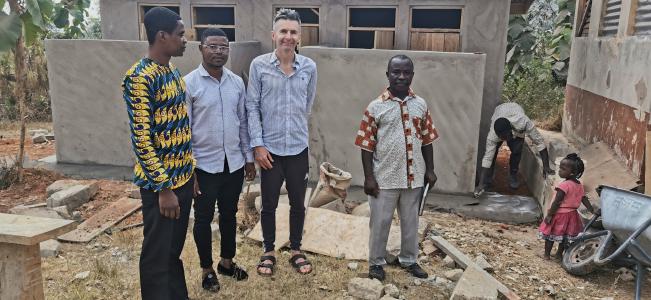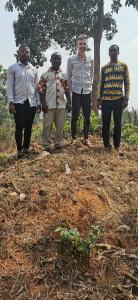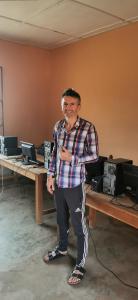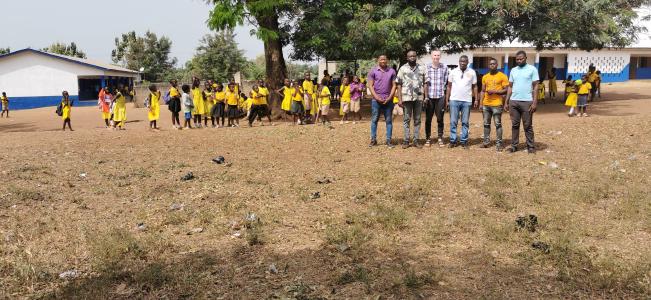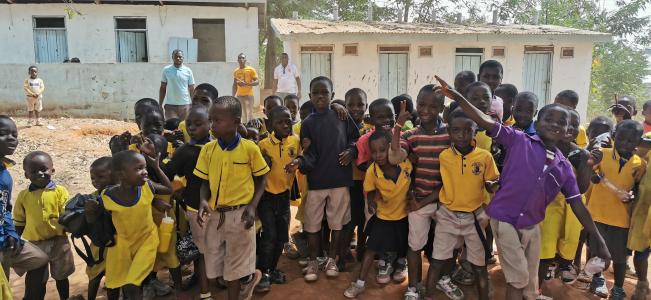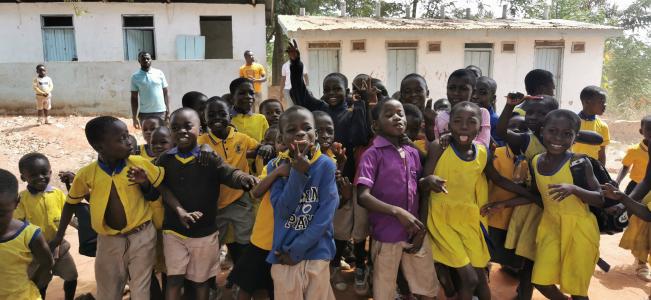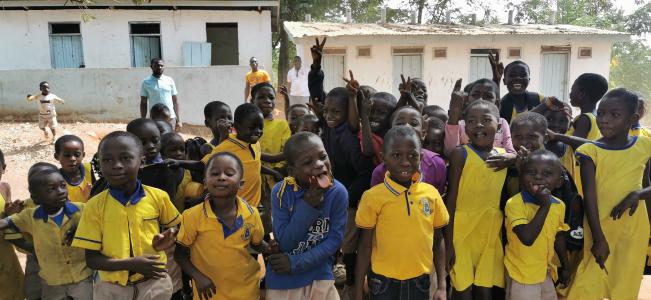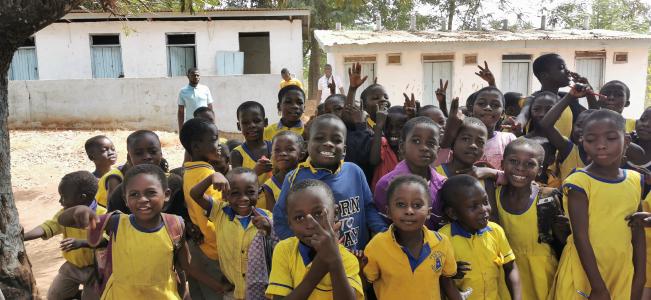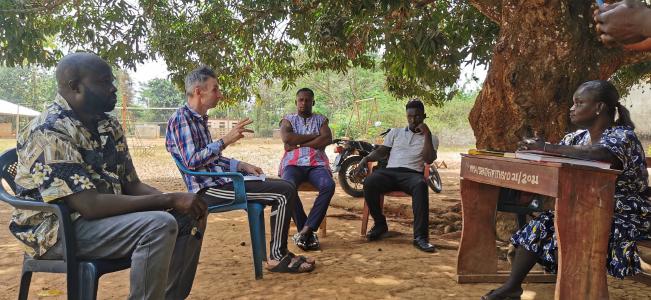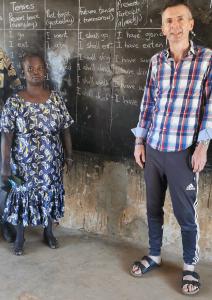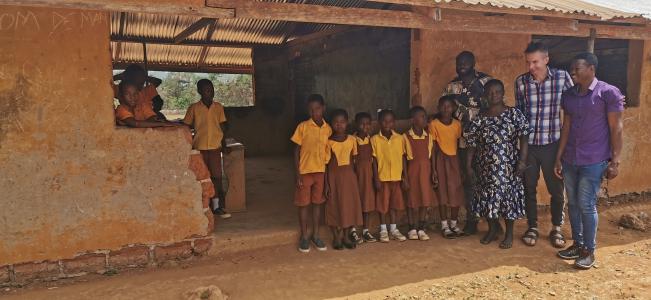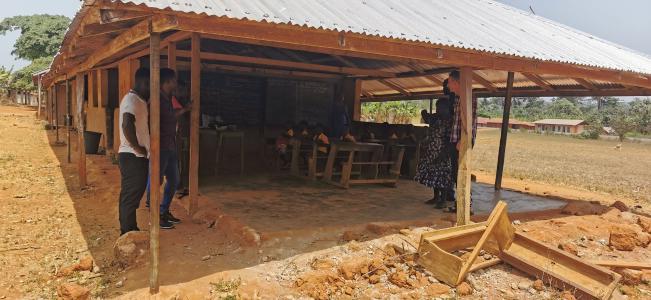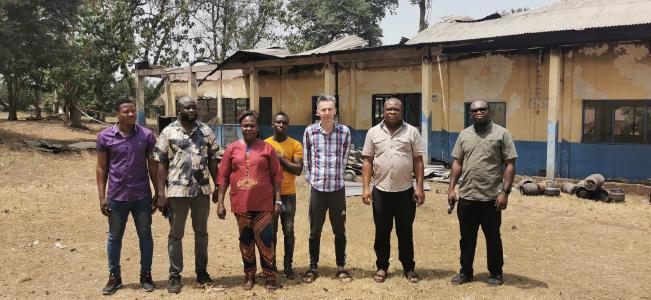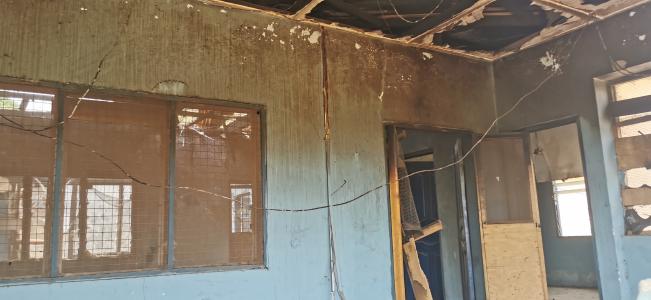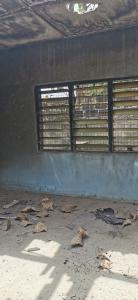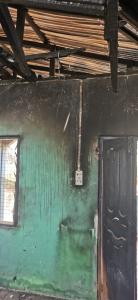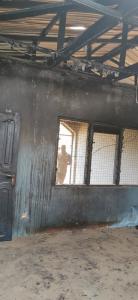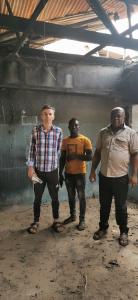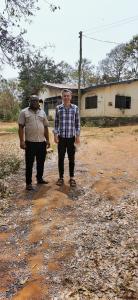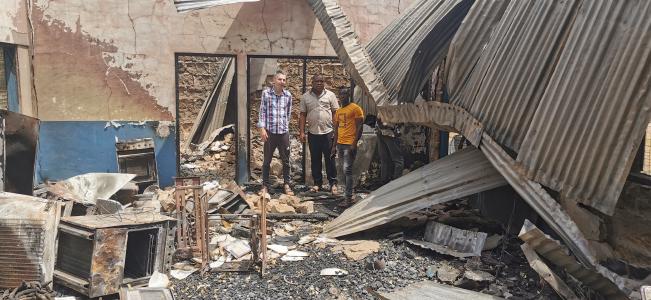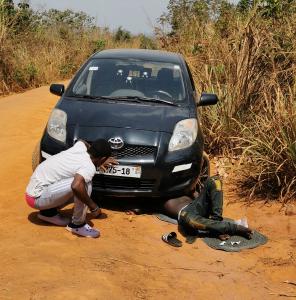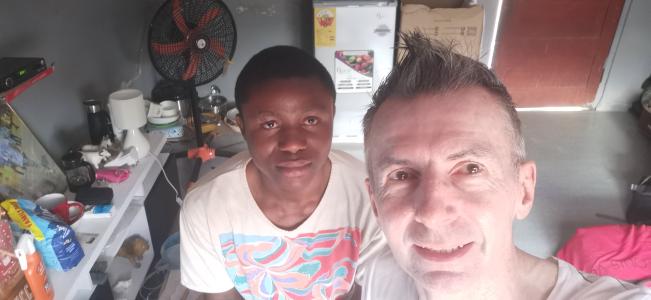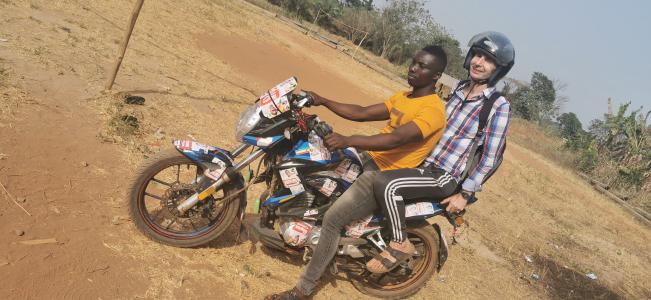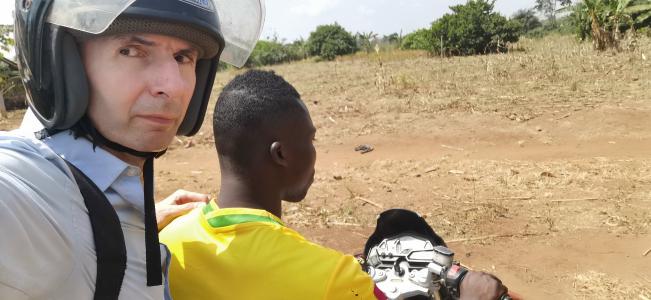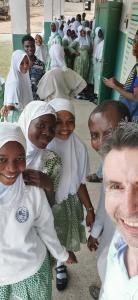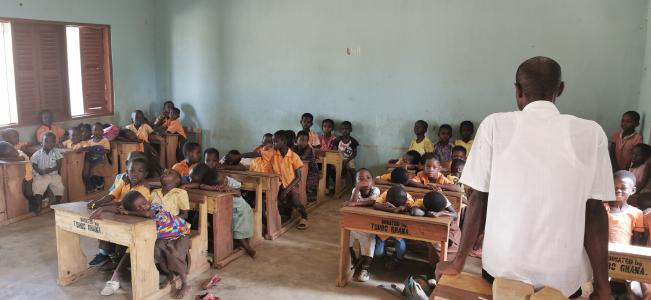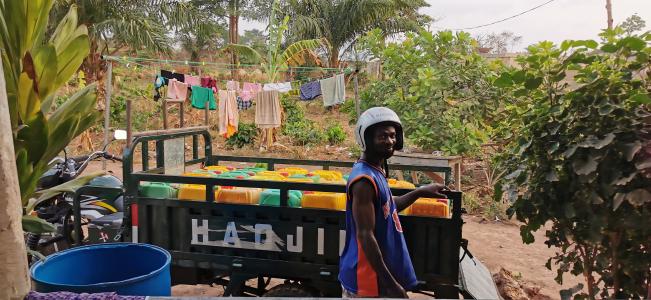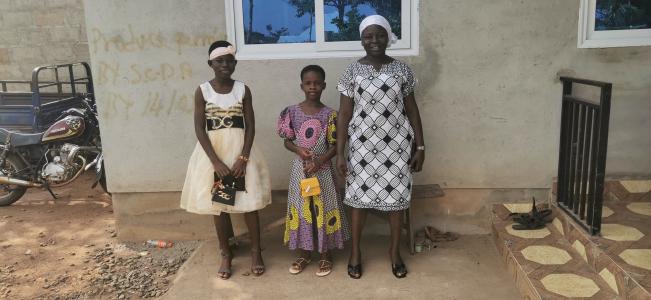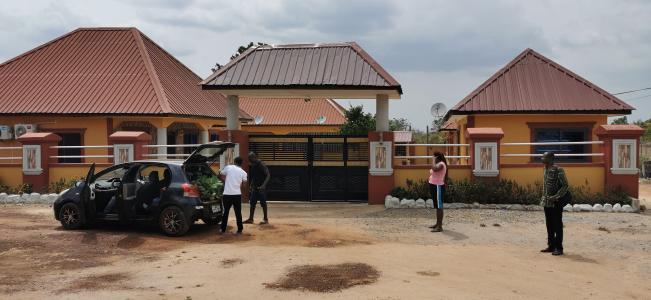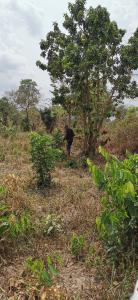Visit in February 2024
February 20, 2024
Atonobi borehole and community
The borehole that we constructed in December 2023 is looking and performing well.
NT (right of me) is the caretaker, and lives next to the borehole. His wife S and sons S (19) and daughter D (17) are also pictured. We had discussion about the water pricing. NT favours a fixed price of 20 cedis/month/household and has tried to implement this (some have paid, some not), while Kwasi favours the more usual system of a price per container. One issue is that some farmers that don’t live in the community would also like to use the borehole.
We didn’t reach a conclusion in the first meeting, so resumed about four days later. Finally, they convinced Kwasi that their price-per-month would work best, with households being charged 20 cedis/month anf farmers 30 cedis/month. There are 14 households, of which 12 have already paid their monthly subscription, and an estimated number of 50 farmers, who have to be identified and asked to pay. If they don’t pay, they can’t use the borehole. In principle, this should generate 14x20 + 50x30 = 1780 cedis per month, which is quite healthy – a borehole typically needs 2-3 repairs per year at 1000-2000 cedis each time.
Kontonho school and teacher accommodation
Really happy that the school and teacher accommodation are making excellent progress. During the week of my visit, the teacher accommodation block got its roof - this will allow the builders to sleep overnight on site temporarily, and hence speed up the remaining work. We expect them to be completed in about 4-6 weeks. Congratulations to Kwasi for wonderful project management. The school has three classrooms and a small office, and measures 22.1m x 5.8m. The teacher accommodation consists of three sleeping rooms and measures 13.8m x 6.1m.
We will build a borehole for this school and the community; our job is really not complete without that, and I think this very deprived community merits it greatly. The water prospecting company has already attended (with laptop) and flagged three possible locations for drilling (stones and stick marking the spot, pictured). They are approximately at this location. In the picture, you can just about see the school (no roof yet, behind Kwasi), and more clearly see the roofed teacher accommodation (behind me).
Anyankamamu school (location)
We have visited this lovely school many times in the last 2-3 years because it is on the way to Aframano, and teacher BA is friends with Kwasi from childhood. They have always asked us for two things:
-
Water. But vexingly, it makes no sense for us to build a borehole here, because the government has already built a mechanised one in 2021. The problem is that it can’t be used until electricity comes to the region. That was promised “within a year” in 2018, and now the promise is still “within a year”.
-
Teacher accommodation. Although we have discussed it many times, I took the opportunity to open up the topic again and ask the four teachers I met if they would really rather sleep in accommodation we build than travel to Kofiase (6 miles, but the road is terrible) where they are currently living. They are all adamant that they want that. “We can’t afford the 300 cedis (£20) each month for our travel, and waste an hour each way”. As a junior teacher’s salary is about 1000 cedis (£65) per month, this is very understandable.
I think Turbo Ghana should build this teacher accommodation, as it has been on our list a long time. It will have 4-5 rooms. The nine teachers are happy with two to a room.
Anyakammu community
Kwasi asked us to visit. It reminded me of Kontonho; the buildings are very poor, the location very remote, but the people are warm and friendly and welcoming. One cannot go there by car, because the path is too narrow, but Evans took me on his motorbike. It’s about 10m by bike from Anyakammu, so walking to school probably takes most of an hour, especially if you are carrying water which you will have to since there’s no water there. Aframano is further, so that will take more than an hour, but at least you benefit from the Turbo Ghana borehole once you are there.
-
Their main ask is a borehole. Currently they get water from the Abena stream, 3 miles, 40 minutes there and 60m back, so almost two hours round trip. They propose to site the borehole by the Kobedu junction (where the path forks), which is reasonably accessible by the 300 people in the community (all scattered). That is about 5 minutes walk from where we met.
-
They also want farmer’s loan. The idea seems to be that 20K cedis (£1200) in total would be lent to 10 farmers for a period of 3 months to a year, and they would repay it at harvest time, possibly with some interest. The same money would then be lent to another goup of 10 farmers, and so on, in perpetuity. I like the idea, but I wonder how it can be managed.
-
Education support. The community sends 10 students to SHS each year. Can Turbo Ghana fund the prospectus for some of them?
Apprenticeship scheme (1)
N studies business management at Kumasi Technical University, and also works as a satellite TV installer. F and J study electrical engineering at KTU. They want to start a business in electrical supplies and installation. M is studying computing and has built a nice interactive website (not yet online).
Apprenticeship scheme (2)
JHS teacher AO at Nsuta Presby school arranged for me to visit two SHS schools to talk about the apprenticeship scheme.
The first one is Nsutaman school, consisting of 2000 pupils (90% boarding) and 200 staff. I met with their head teacher VU. They assembled their SHS3 students (about 500 I think) in the assembly hall, and I described how Turbo Ghana could fund apprenticeships in construction industries (carpentry, electrician, building, etc.) and the social sector (dressmaking, hairdressing). There were good questions from the students, such as about the location of the apprenticeships (we will focus locally for now), whether apprentices would have to pay (no, we pay), and whether there could be follow-on funding (yes in principle, to be decided based on the apprenticeship results). I also talked aboout the monitoring (monthly milestones established at the start, and reports from the trainer monthly for the first 6months and then 6-monthly).
The next one is a small private school that specialises in students that have failed SHS and want to retake. It is a recently-established school (2021) and charges 4000 cedis/year. I met with the assistant head Joseph Boateng, and I addressed a smaller group (about 50) which was nice because it could be more interactive.
Apprenticeship scheme (3)
SB introduced five students: S (17), J (18), B (18), B (30), and F (28). The women all want to become tailors; three have identified MO as a possible host for their apprenticeship, and one has identified KK. We initially thought of selecting one or two of the women, but my later thought is to allow all four of them to start, recognising that a certain drop-out rate is inevitable (either because the apprentice changes their mind, or they underperform and we decide to end the apprenticeship). Stephen wants to become electrician but I got the feeling he is not ready yet.
They all live in Kruwi, about 7km or 15 minutes by car from the apprenticeship hosts MO and KK in Nsuta. If they commute, it will take about 30-45 minutes for travel (including waiting time) and it will cost 150-250 cedis/month. If they rent a shared room in Nsuta, it will cost a similar amount, but there will be food and water expenses too. They will also buy a sewing machine (1000 cedis manual, or 3000 cedis electric), and the trainer requires a fee of 1000-1500 cedis. Kwame has given us his “prospectus”, which is the list of start-up costs for an apprentice (see photo). I think each apprenticeship will cost Turbo Ghana about £300 up front, and about £1000 in total if the candidate stays to completion.
On the question of commuting vs renting a shared room, there was a lot of discussion with advantages of each one being expressed. In the end, the conclusion was to start off with commuting, and to go for the rented room arrangement if the need arises.
My host and friend V knows KK and lives nearby, so she will kindly monitor the progress of the apprentices on behalf of Turbo Ghana. Senior teacher SB (who introduced us to the women) will also monitor; he also lives nearby.
Nsutaman school borehole
Head teacher VU told me they need help with their boreholes. I visited the boreholes with JM (French teacher) and RE (SHS3). I learned that the lower boreholes feed the tank near the school, but only one of the three is working, and only intermittently. R understands the system well, was very good at demonstrating the problem to me. I learned that, to try to improve the situation, the school has moved the pump formerly at the near-school borehole to the one near the entrance. I’ve asked V to write us a letter, detailing and motivating their requirement from us, after consulting her staff members and appropriate experts. She should include pricing information in the letter.
Bunuso
Through Kwasi, we received a letter from HMY, PK and NM, and met them. Bunuso has about 500 households and a population of 3600.
They have requested a public toilet, which is an unusual request (most villages want one private toilet per household), and an interesting one because it is considerably less expensive. The photos show the current “toilet site” with bushes which they currently use for their daily needs. The challenge of building a public toilet is to ensure it is properly maintained. The options are a subscription model (monthly payment) or a pay-per-use model, to generate a fund for maintenance. A committee would administrate the fund.
They also request the mechanisation of their three manual boreholes. Currently the water cost is 10p per gallon container. I pointed out that it will cost more if the borehole is mechanised, since they’ll have to pay for the electricity too. There was some discussion, and a new price of 30p per gallon was suggested. A woman called B spoke up and said it was worth it. Other women agreed. That’s because it will mostly save women’s work. So I think it is worth it.
By the Bunuso school, there is a school-owned borehole (pictured) which is out of repair. They lack the funds to repair it. School water is not charged, so the method of using the charges to pay for repairs doesn’t work in the case of a school borehole. The school serves 570 pupils and 21 teachers, divided into KG, primary and JHS. I talked to M, the head teacher.
The photo shows that the school toilet was refurbished by IBWPPI & BTAC, and I found this article describing their work.
After the main meeting, we had an impromptu second meeting as we walked around the village. We talked to some women who hadn’t managed to come to the main meeting.
Pataase Sesease Kokoben (PSK)
This is three villages with a population of 1500, known together as PSK. They sent us a letter via Kwasi. George Attakora is the assemblyman covering this area, and is a colleague of Kwasi.
They have three requests for us:
School completion. They have a government-built school with two classrooms (JHS 1 and 2), but they lack JHS 3. In 2023 they started a community fundraise to find money to build an additional classroom, and raised about 30K cedis (£1900), and started the project (see photos). The money was raised when the village had a “homecoming day” for former villages that returned for a visit, and about 200 people contributed. Thomas Sarfo project managed so far. They ask Turbo Ghana to complete the project. They estimate that 100K cedis (£6300) is needed to complete it. The current student population for JHS 2 is 45, and currently the JHS 3 population walks a mile to the next school.
Public toilet. PSK has no toilets and people defacate in the bush. In our meeting, they asked for a toilet block with 15 seats. I asked if they would prefer two blocks of 7 seats each, and they agreed. Then why not three blocks of 5 seats each, etc. KA (purple shirt) was very articulate and proposed that they would hold a meeting with the elders and decide what was the best solution and come back to us. I asked how the block(s) would be maintained, and we discussed a flat fee of 10 cedis/household/month to generate a fund for maintainance. Kofi said that in their meeting, they will also calculate whether 10 c/h/m is the right price.
Water. They currently go to the Kokobenmu stream to fetch water. I went there with them. The walk took about 15m, down a dirt track which is steep in some places, to a lovely spot with a stream of clean water flowing over rocks. Because it’s in a little valley, it’s cool and wet there, which is very pleasant. Some women came to fetch water while we were there. Matilda comes there 3x per day, but Adoma comes 7x on some days, particularly Mondays because it’s taboo to come on Tuesdays so on Monday she has to fetch water for Tuesday too. The way back takes longer because it’s uphill and you are carrying water on your head. Then you have the time spent filling your containers, which isn’t easy because the water is shallow. So the round trip takes about an hour.
There was some discussion about how to prioritise their needs. Everyone thought the school is the biggest priority, but there were differing views about whether water or toilets come next. I think toilet won.
Nkubeta
It’s a more urban village compared to PSK and Bunuso. Kwasi brought me here. Their ask is:
-
Toilet. They have a dilapidated toilet block and want a new one. I asked what will prevent the new one becoming similarly dilapidated? They will appoint a caretaker and charge for use to have a repair fund. Why didn’t you do that with the existing toilet block?
-
Clinic. They say Mampong is too far (although I think it is 10 minutes by car or motorbike).
-
Mechanised borehole. They have piped water from Mampong but sometimes it fails. I asked why they don’t have a polytank to fill while it is working, and draw from it when the piped water fails.
-
Teacher accommodation, so teachers could give evening classes for the students.
I found Bunuso PSK to be a more convincing case of a community trying to help itself and having better ideas about how to ensure that assets build using our funds would be sustainable and long-lived.
Kruwi JHS
SB invited me to this school. It consists of 150 pupils in KG/primary, and a further 70 in JHS, with 21 teachers. I met OAD (head teacher) and BT (assistant head).
An Accra-based businessman called Benz Gate recently donated for a toilet block (3 seats) for the primary school, being built at the time of our visit (pictured). IIUC, Benz Gate is the owner of Mercedes-Benz distributorships in Ghana. He also contributed for repainting the school and some electrician work.
Their kindergarten school was built by Ashanti Development.
Their ask from Turbo Ghana is
-
Toilet for JHS (3 seats)
-
Teachers accommodation (8 rooms), motivated by evening classes and morning attendance
-
Borehole
SB said that it’s a very performant school (top 1-2 out of 60 in the region, top 6 in the wider region, based on exam results). Their computer room (pictured) has about 10 desktop computers which look like they probably work (but they were all turned off when I was there).
Nkwanta Methodist Primary
Engineer John is my contact at the Mampong Municipal Assembly, and I know him because of our correspondence about our building the Aframano school and the Kontonho school. He took me to the Nkwanta Methodist Primary school to hear of their needs. The school has 560 pupils across kindergarten and primary. I met with the head teacher GA, who, in the course of describing their challenges, told me from memory the sizes of their classes:
| KG1 | KG2 | P1 | P2 | P3 | P4 | P5 | P6 |
|---|---|---|---|---|---|---|---|
| 120 | 60 | 57 | 95 | 65 | 62 | 63 | 51 |
The notable number is the 120, as this group will move up a class each year. Currently KG1 is divided into two classes, but they don’t have enough classrooms to divide the 95 in P2, and they won’t be able to divide the 120 as it moves up the years. So space is a big problem for them.
Their ask:
-
6-classroom block. This would double their current room count, which the numbers seem to justify. Interestingly, they started a community-initiated project to build three classrooms a few years ago, and it is half-built and derelict due to lack of funds. Engineer John was not interested in my idea that Turbo Ghana could continue this project, because he wants us to build the 6-room block. That is because he thinks we are much richer than we are, so this conversation will continue. John has a standard design for 6-room school block, together with costings, so he will send them to us. I know it will be considerably more expensive per square metre than our recent building projects, so that’s another reason why more discussion will be needed before we can adopt this project.
-
The school also wants its own borehole. There is a local community borehole which they sometimes use. It is based on a payment model, and the school sometimes pays, but it doesn’t have any budget.
The school has a toilet block which the community has partly renovated.
Nwaadan school
This is a small school (114 pupils, 18 teachers) in a lovely spot set back from the main road and with trees. I met with the head teacher Mrs FFA.
They have three blocks:
-
A four-room block for P1-4. But this mud-built block has partly fallen down, and one of the rooms is completely missing a wall. The building is being propped up by temporary steel poles which were donated.
-
A three-room block for P5 and 6; the third room is partitioned in two with plywood and houses KG1 and KG2.
-
A JHS block with three rooms, which I didn’t visit.
We were taken there by Engineer John who wants us to fund his standard 6-room block to accommodate P1-6, so that the three-room block could be used for KG, and the four room block could be demolished. This is indeed sorely needed.
They also want a borehole. Children walk to the stream, 15m walk, takes about 45m for the round trip. The MP had secured government funding for a community borehole (which the school couldn’t use) but anyway it’s not working now because of an electrical fault. I asked F how any borehole Turbo Ghana may build could avoid the same fate. She proposed to charge 10 cedis per child per term to maintain a fund for borehole repairs, and said the fund would be managed by the school management committee and the PTA, both of which are chaired by a parent.
F is likeable and sharp-witted. I asked whether she wanted manual or mechanised. “Manual will do” she said, but was quickly persuaded by John that she should ask for a mechanised borehole (again indicating his exaggerated opinion of our funds). F had many questions for me. Will you also supply furniture? (Yes.) An ICT room with laptops? (No, but I wish.) When will you start? (We are gathering projects, and have at least 10 big ones, and our trustees will have a prioritisation meeting, hopefully in March.)
In an ideal world, F also wants a teacher accommodation block.
St Joseph’s SHS Mampong
Engineer John took me to meet the head teacher Rev Fr IOM. It’s a big school on a big campus (3000 pupils). They had two fires, one last year, and one two weeks ago:
Last year the teachers’ accommodation (4 rooms) burned down. The contents of the four rooms were burned completely, although the building is still structurally sound so can be refurbished. A sleeping occupant heard sparks and fled when the fire started. She is now “squating with friends”. Another teacher, who was not present, was so traumatised by the loss of all his possessions (and I suppose the possibility that he could have lost his life) that he quit his job. The fire department has not yet sent its report, although the fire is suspected to be due to an electrical fault.
Two weeks ago, the home economics block (two rooms) burned down, again due to a suspected electrical fault. The destruction was worse, because of the presence of gas cylinders that exploded. When we visited, I saw there were some burned-out sewing machines. “What pains me particularly is that we had just bought them”, said Rev Isaac.
Our discussion gave me the opportunity to find out a bit about the financial management of schools in Ghana. The government supplies teachers, but no cash. St Joseph’s has a small “internally generated fund” (IGF), based on below-market rent from teachers who stay in the accommodation block, and a tax on food sales within the school (people wanting to sell food in the school have to pay a little tax to the school). This is enough to cover light bulbs, pens and paper.
Engineer John’s department has made a drawing of the new home economics block that they want, and will send it to us. I told him that if it is expensive we will not fund it, but if it is cheap we will try. He said it’s about 500K cedis (£31K). Let’s see what the trustees say. He might tell us the refurb cost of the teacher accommodation too, which will obviously be cheaper.
